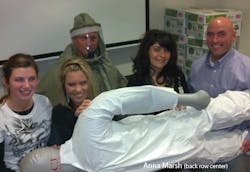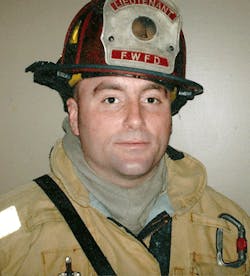The Decontamination Challenge in Hospital Emergency Preparedness
The life of a hospital emergency preparedness coordinator (EPC) is an exercise in prioritization. The day starts with errant fire alarms and security actions, continues with a crushing schedule of meetings and trainings, and often ends late at night with the EPC wondering, “What just happened? What did I accomplish? Did I make my hospital safer today?”
In this hectic schedule, there isn’t a lot of time to engage your facility and staff in serious disaster preparation. Fire alarms, snow emergencies and “Code Pink” or child abduction drills often are practiced through the year. While these are important, the incident that is too often overlooked is that of a contaminated patient or patients arriving at your emergency department.
The disaster is not the arrival of the contaminated patients. The disaster will be when the primarily contaminated victim arrives at your door and then secondarily contaminates your emergency department, staff and other patients. It is incumbent upon the receiving entity to triage, decontaminate and treat contaminated patients.
Meet Anna Marsh
In Fort Wayne, Ind., there’s a new variation on that theme: “If you want something done, ask a feisty emergency preparedness coordinator with four daughters, bible study, kick boxing classes and one of the states largest hospital facilities in her charge.”
In other words: If you need something done, give it to Anna Marsh.
Anna Marsh is the emergency preparedness coordinator for Parkview Regional Medical Center (PRMC) in Fort Wayne, Ind. PRMC is an expansive facility opened in 2012 on the north side of this city of 250,000 people. It covers 4 million square feet of real estate that includes a nine-story tower of inpatient rooms and services and a helicopter full of jet fuel perched on the roof. The facility is projected to have over 50,000 emergency department visits this year. Anna has her hands full, and she not only thinks about hazardous materials and contaminated patients, but she has a solid workable plan for handling them. More importantly, she has a plan for getting her staff trained.
The Contamination Challenge
Patients come to the emergency department in a contaminated state. With methamphetamine production, contaminated fire victims and industry catastrophes, it is a fact of life. Ideally, first responders on the scene will give advanced warning of their arrival. Most ambulance services have written policy that they will not transport contaminated patients, and expect fire personnel to do a gross decontamination of the patients at the scene.
But this doesn’t always happen. Many times poor judgment, bad information and adrenaline lead to contaminated patients getting loaded into an ambulance with nothing more than a slap on the side of the bus and a “Let’s go!”
Then there are the “self referred” patients who arrive in their own vehicles from known hazardous materials incidents, and those that are covered in chemicals from clandestine labs. These patients already are primarily contaminated when they arrive. The goal is to stop them from secondarily contaminating the emergency department, the hospital staff and the other patients.
The Emergency Action Plan
The lowest common denominator in Anna’s plan is to train the entire staff to recognize contaminated patients, hazardous materials in the facility, and how to notify the proper resources. The next steps are to contain the patient and keep the secondary contamination to a minimum until the patient is properly decontaminated and the waste is contained. The evolution of decontaminating patients while wearing personal protective equipment is defined by HAZWOPER as an operation-level activity.
This operations-level work of decontamination must be completed by properly trained and properly outfitted staff. They will move the contaminated patients through a decontamination corridor that terminates at the emergency department or the post-decontamination zone. The patients have to be triaged in the pre-decontamination zone, separated into ambulatory and non-ambulatory groups and have their belongings properly catalogued and stored. Once in the decontamination corridor, the patients have to be properly decontaminated with their modesty and comfort in mind.
The OSHA Standard and Training
OSHA CFR1910.120 covers the entire situation from defining which staff members need to be protected, how they are trained and how often they are refreshed in that training. The standard, which is defined in “Best Practices for Hospital-Based First Receivers of Victims,” divides the staff into those who should be awareness-trained to handle contaminated patients and those who need operations-level training in the area of decontamination.
The funding for classes and equipment typically comes from ASPR grants that are designed specifically to fit this need. In the state of Indiana, the funding is distributed by district and the dollar amount per facility is determined by number of emergency department visits. Emergency preparedness coordinators have reported that Joint Commission surveyors are asking for proof of an emergency action plan to handle contaminated patients, as well as proof that staff is properly trained to handle the operation.
Awareness-level training is required by OSHA for any employee who is in proximity to the decontamination corridor, who may be exposed to self-referred patients or who may be exposed to facility hazardous materials. This definition encompasses almost all hospital staff and creates a nearly impossible training scenario. Anna has chosen a targeted approach to providing this training. She determined who was most at risk to contamination and offered the training to them first. This included patient access, security, emergency department staff, and environmental services.
Operations-level training is required for any staff involved in the decontamination process. It requires a minimum of 8 hours of initial training and should include PPE, respiratory protection, decontamination theory, decontamination practice and construction of the decontamination corridor. To do this operations-level work, EPC Anna Marsh has chosen staff who are competent, interested and not directly involved in patient care. These hardy souls include patient access, environmental services, security and emergency department techs.
The EPC as Gardener
I am not lying when I tell Anna that she scares me “just a little bit.” At first I thought it was her confidence, and possibly the kickboxing, but then I realized it was that I knew her kind from my other occupation, firefighting.
Anna would have made a good rescue captain had she chosen to join the fire service. She is focused and directed in her questions like a hardened fire captain. Fire/rescue work is all about prioritization. “Where is the fire? Where are the viable victims? How do we get to them and extricate them?” This is Anna’s day, and it’s every EPC’s day. They are the problem hunters and problem solvers. They can respond to a fire alarm while answering the security phone, and they can put a rowdy family member back in his lobby chair with only a look as they pass through the patient access area. The ability to prioritize is the key to survival.
I have learned something else while working with Anna: hunting problems is often times the easy part. Problem solving makes the endorphins flow and the synapses fire, and it elicits the thrill of the chase. It is why people choose careers in health care and the emergency services. It is also the smaller part of a bigger picture. Gardening is where the majority of the work is done.
The EPC has to be a nurturer. She has to develop policy, emergency action plans and, most importantly, she has to develop her staff. Just like that rescue captain, EPC Anna Marsh has to spend a large amount of her time building her crew, selecting their training and refreshing that training. She knows that when her staff is in the heat of battle and the adrenaline is flowing, they will fall back on muscle memory and instinct. Training and repetition is where that muscle memory and instinct is built.
Contaminated patients can make a routine health problem a life-threatening emergency if emergency department, staff and other patients are contaminated. These are the high risk-low frequency situations that can bring a hospital to its knees and make your facility the lead on the nightly news.
Anna Marsh and the emergency preparedness coordinators of Parkview Health are training their staffs for that eventuality, building that muscle memory. They are managing to get it done somewhere in between kickboxing and bible study.


